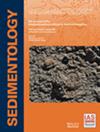Sedimentary evolution and sequence stratigraphy of Ediacaran high‐grade phosphorite–dolomite‐shale successions of Bocaina Formation (Corumbá Group), Central Brazil: Implications for the Neoproterozoic phosphogenic event
IF 2.8
2区 地球科学
Q1 GEOLOGY
引用次数: 1
Abstract
Extensive phosphorite deposition is observed in the Neoproterozoic after a prolonged hiatus during most of the Mesoproterozoic era. This event is thought to represent an important record of major palaeoenvironmental, palaeoceanographic and biotic changes that shaped Neoproterozoic ecosystems, suggesting close relationships between phosphogenesis and the preservation of key Ediacaran biotas. However, high‐grade Ediacaran phosphorite deposits are relatively uncommon, diminishing the opportunity to test current phosphate mineralization–deposition models and their implications for Neoproterozoic research. In this scenario, widespread Ediacaran phosphorite–dolomite–shale successions of the Bocaina Formation (Corumbá Group – Central Brazil) are poorly explored in international literature. Nevertheless, recent advances in phosphate exploration gave access to continuous drill core sections and freshly opened mine pits, revealing an unprecedented record of complex phosphatic successions featuring the occurrence of Ediacaran microfossils assigned to the Doushantuo–Pertatataka assemblages. This work seeks to constrain main lithofacies, sequence stratigraphy and depositional settings from these phosphatic successions in order to analyse the sedimentary evolution of the unit under the current Neoproterozoic phosphorite research framework. These results indicate that the Bocaina Formation records secular sustained phosphate deposition. These deposits are related to unprecedented, microbialite reef rim phosphorites deposited during a lower accretionary rimmed platform stage, followed by the deposition of Doushantuo‐like, whole platform phosphorites associated with a later, drowned platform stage, therefore, reinforcing the evidence for the operation of strong allogeneic controls on phosphate mineralization–concentration. In addition, this study concludes that fossiliferous Ediacaran phosphatic deposits such as the Bocaina Formation are important to understanding Neoproterozoic phosphogenic events, because they may record the transition from a Precambrian to Phanerozoic‐like phosphogenesis associated with the instauration of the Ediacaran–Cambrian phosphatic taphonomic window. This evidence hints that the growing dataset from the Bocaina Formation may bring new, exciting perspectives for Neoproterozoic research as a whole.巴西中部埃迪卡拉系Bocaina组(corumb群)高品位磷矿-白云岩-页岩序列的沉积演化与层序地层学:对新元古代磷矿事件的启示
本文章由计算机程序翻译,如有差异,请以英文原文为准。
求助全文
约1分钟内获得全文
求助全文
来源期刊

Sedimentology
地学-地质学
CiteScore
8.20
自引率
11.40%
发文量
94
审稿时长
6-12 weeks
期刊介绍:
The international leader in its field, Sedimentology publishes ground-breaking research from across the spectrum of sedimentology, sedimentary geology and sedimentary geochemistry.
Areas covered include: experimental and theoretical grain transport; sediment fluxes; modern and ancient sedimentary environments; sequence stratigraphy sediment-organism interaction; palaeosoils; diagenesis; stable isotope geochemistry; environmental sedimentology
 求助内容:
求助内容: 应助结果提醒方式:
应助结果提醒方式:


